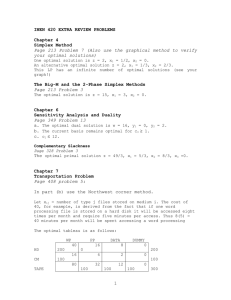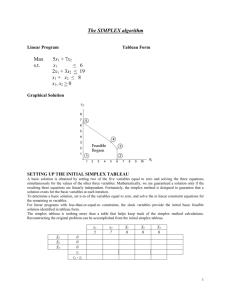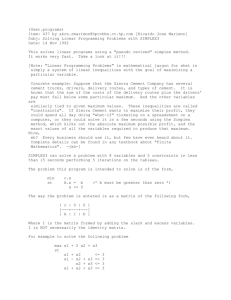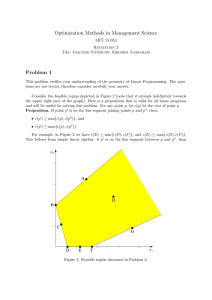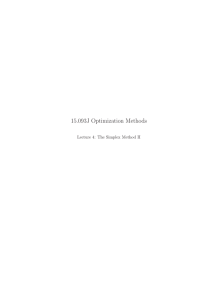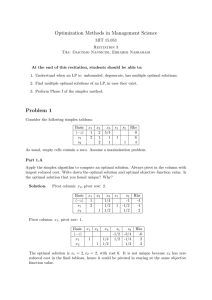Document 13619597
advertisement
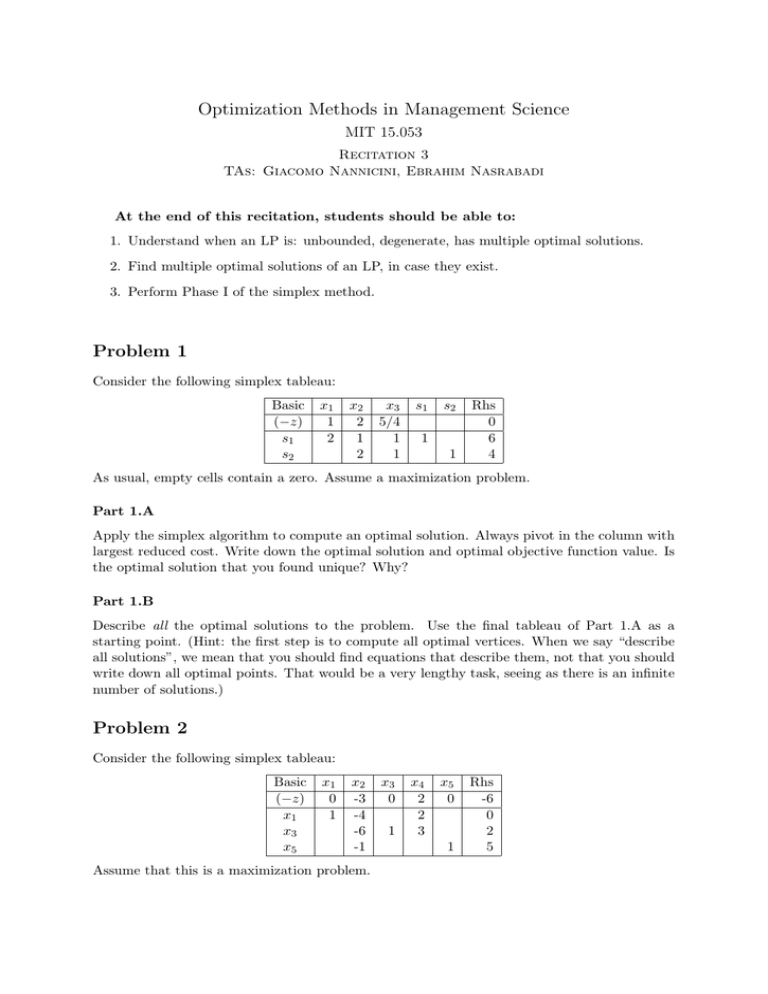
Optimization Methods in Management Science MIT 15.053 Recitation 3 TAs: Giacomo Nannicini, Ebrahim Nasrabadi At the end of this recitation, students should be able to: 1. Understand when an LP is: unbounded, degenerate, has multiple optimal solutions. 2. Find multiple optimal solutions of an LP, in case they exist. 3. Perform Phase I of the simplex method. Problem 1 Consider the following simplex tableau: Basic (−z) s1 s2 x1 1 2 x2 2 1 2 x3 5/4 1 1 s1 s2 1 1 Rhs 0 6 4 As usual, empty cells contain a zero. Assume a maximization problem. Part 1.A Apply the simplex algorithm to compute an optimal solution. Always pivot in the column with largest reduced cost. Write down the optimal solution and optimal objective function value. Is the optimal solution that you found unique? Why? Part 1.B Describe all the optimal solutions to the problem. Use the final tableau of Part 1.A as a starting point. (Hint: the first step is to compute all optimal vertices. When we say “describe all solutions”, we mean that you should find equations that describe them, not that you should write down all optimal points. That would be a very lengthy task, seeing as there is an infinite number of solutions.) Problem 2 Consider the following simplex tableau: Basic (−z) x1 x3 x5 x1 0 1 x2 -3 -4 -6 -1 Assume that this is a maximization problem. x3 0 1 x4 2 2 3 x5 0 1 Rhs -6 0 2 5 Part 2.A What is the current basic feasible solution and its objective function value? Is the current bfs degenerate? Part 2.B Perform one pivot. What is the new basic feasible solution and its objective function value? Did anything change with respect to the previous bfs? And with respect to the previous tableau? Part 2.C The tableau that you obtained after Part 2.B is not optimal because some reduced cost is positive. In fact, the problem is unbounded (why?). Give the equations describing a ray of the feasible region along which the objective function can be increased indefinitely. Problem 3 Consider the following LP: max ⎫ x1 + 3x2 ⎪ ⎪ ⎬ 2x1 − 2x2 = 1 x1 + x2 ≥ 5 ⎪ ⎪ ⎭ x1 , x2 ≥ 0 (LP) Observe that a basic feasible solution is not readily apparent. We want to perform Phase I of the simplex method to find an initial basic feasible solution. Part 3.A Add surplus and artificial variables as needed to perform Phase I, then determine the Phase I objective function. Write the resulting LP and the corresponding initial Phase I simplex tableau. What is the basic feasible solution in this tableau? Part 3.B Perform two iterations of the simplex algorithm on the tableau obtained at the end of Part 3.A. Is Phase I completed? If we now have a basic feasible solution for the original problem, explain why and write the solution. If we do not have a basic feasible solution for the original problem, explain why. Problem 4 (Note: this problem is more difficult than the rest, and will require some serious thinking. You will not be tested on Problem 4 in the upcoming quizzes, problem sets or midterms. However it is very useful for understanding some subtleties of Phase I of the simplex method.) Suppose that we have an LP with three nonnegative variables x1 , x2 , x3 to which we have to apply Phase I of the simplex method to find an initial basic feasible solution. The artificial variables are labeled s1 , s2 , s3 . After a few iterations of the simplex method in Phase I, we obtain the following optimal tableau with an objective function value of zero, where b is a parameter that will be specified later: 2 Basic (−w) x1 x2 s2 x1 x2 1 1 x3 -1 2 1 b s1 -3 1 -3 1 s2 1 s3 -1 2 5 -1 Rhs 4 1 The artificial variable s2 is still basic, therefore we do not have a basis for the original problem. But the objective value of Phase I is zero, therefore a bfs for the original problem exists. Our goal is to find a basis to start Phase II of the simplex method. Part 4.A Assume b = −2. How do we proceed in this case? Determine a basis for the original problem and the corresponding tableau that can be used to start Phase II (after restoring the original objective function, which is not relevant for the purposes of this problem). (Hint: try to perform a pivot to drive the artificial variable out of the basis; this pivot may be something that you are normally not allowed to do, but notice that the basis is degenerate.) Part 4.B Assume b = 0. How do we proceed in this case? Determine a basis for the original problem and the corresponding tableau that can be used to start Phase II restoring the original objective function. (Hint: write down the equation corresponding to the last row of the tableau, and observe that this is a linear combination of the original constraints. What does this row mean in terms of the original equations?) 3 MIT OpenCourseWare http://ocw.mit.edu 15.053 Optimization Methods in Management Science Spring 2013 For information about citing these materials or our Terms of Use, visit: http://ocw.mit.edu/terms.

